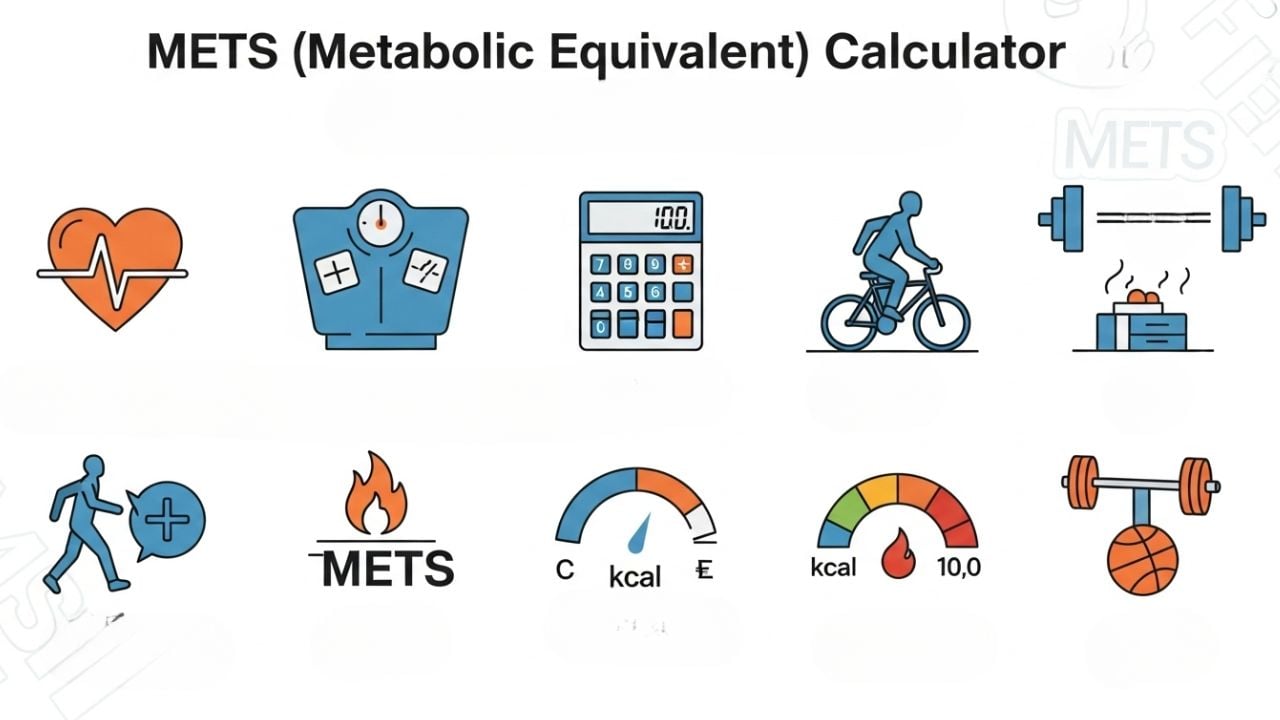METs Calculator
Calculate your Metabolic Equivalent (METs) and calorie burn for over 100 physical activities using research-based formulas from the Compendium of Physical Activities

METs (Metabolic Equivalents)
METs (Metabolic Equivalents) are a standardized way to measure the energy cost of physical activities. One MET represents the amount of oxygen your body uses while sitting quietly at rest, which equals approximately 3.5 milliliters of oxygen per kilogram of body weight per minute. According to research published in Bone & Joint Research, METs provide a useful metric for comparing high-functioning individuals and capturing additional health benefits beyond conventional measures.
Scientific Foundation
The concept of metabolic equivalents was first introduced in exercise testing and prescription. Foundational research published in Clinical Cardiology established METs as a reliable method for evaluating functional capacity and prescribing exercise intensity. The system allows healthcare professionals and fitness experts to standardize activity recommendations across different populations and fitness levels.
Clinical Applications
METs are extensively used in clinical settings for cardiac rehabilitation, fitness assessments, and health monitoring. The standardized nature of MET values allows for consistent evaluation of physical activity levels and energy expenditure across diverse populations, making them invaluable for both research and practical applications in healthcare and fitness.
Compendium of Physical Activities
Our calculator uses MET values from the official Compendium of Physical Activities, a comprehensive research database that provides standardized MET values for hundreds of activities. This ensures accuracy and consistency with scientific literature and clinical practice guidelines used worldwide by exercise physiologists and health professionals.
METs Calculation Formulas & Scientific Basis
Physical Activity Intensity Classifications
| Intensity Level | MET Range | Example Activities | Health Benefits | Target Population |
|---|---|---|---|---|
| Sedentary | ≤ 1.5 METs | Sleeping, sitting, lying down | Rest and recovery | All populations |
| Light Intensity | 1.6 – 2.9 METs | Slow walking, light housework, desk work | Basic daily function, minimal cardiovascular benefit | Sedentary individuals, rehabilitation |
| Moderate Intensity | 3.0 – 5.9 METs | Brisk walking, recreational cycling, dancing | Cardiovascular health, weight management | General population, health maintenance |
| Vigorous Intensity | 6.0 – 8.9 METs | Jogging, competitive sports, circuit training | Enhanced fitness, performance improvement | Active individuals, athletes |
| Very Vigorous | ≥ 9.0 METs | Running, competitive cycling, intense sports | Elite fitness, athletic performance | Athletes, highly trained individuals |
Source: Classifications based on the American College of Sports Medicine (ACSM) guidelines and the Compendium of Physical Activities research database.
Common Activities & Their MET Values
| Activity Category | Specific Activity | MET Value | Intensity | Calories/Hour (70kg person) |
|---|---|---|---|---|
| Daily Living | Watching TV | 1.3 | Sedentary | 91 |
| Daily Living | Cooking | 2.5 | Light | 175 |
| Daily Living | Cleaning house | 3.3 | Moderate | 231 |
| Walking | Slow pace (2.5 mph) | 2.5 | Light | 175 |
| Walking | Moderate pace (3.5 mph) | 4.3 | Moderate | 301 |
| Walking | Brisk pace (4.5 mph) | 7.0 | Vigorous | 490 |
| Cycling | Leisure (<10 mph) | 4.0 | Moderate | 280 |
| Cycling | Moderate (12-14 mph) | 8.0 | Vigorous | 560 |
| Running | 5 mph (12 min/mile) | 8.3 | Vigorous | 581 |
| Running | 7 mph (8.5 min/mile) | 11.0 | Very Vigorous | 770 |
| Swimming | Freestyle, moderate | 8.0 | Vigorous | 560 |
| Sports | Tennis, singles | 8.0 | Vigorous | 560 |
| Sports | Basketball, game | 8.0 | Vigorous | 560 |
| Strength Training | Weight lifting, moderate | 3.5 | Moderate | 245 |
| Strength Training | Circuit training | 8.0 | Vigorous | 560 |
Note: Calorie estimates are for a 70kg (154 lb) person. Actual calorie burn varies based on individual factors including body weight, fitness level, and exercise efficiency.
Health Benefits & Physical Activity Guidelines
🏃 Cardiovascular Health Benefits
Moderate Intensity (3-6 METs): Aim for 150 minutes per week (500-750 MET-minutes)
Vigorous Intensity (≥6 METs): Aim for 75 minutes per week (450+ MET-minutes)
Combined Approach: Mix moderate and vigorous activities for optimal cardiovascular benefits
Research shows that achieving 500+ MET-minutes per week significantly reduces cardiovascular disease risk.
💪 Weight Management Applications
Weight Loss: Target 1,500-2,000 MET-minutes per week for significant weight loss
Weight Maintenance: 500-1,000 MET-minutes per week helps maintain healthy weight
Calorie Balance: Use MET calculations to balance energy intake and expenditure
Higher intensity activities (≥6 METs) provide greater calorie burn per unit of time.
🧠 Mental Health & Cognitive Benefits
Stress Reduction: Moderate activities (3-6 METs) effectively reduce stress hormones
Mood Enhancement: Regular activity at 4+ METs improves mood and reduces depression
Cognitive Function: Activities ≥3 METs support brain health and memory
Even light activities (1.6-2.9 METs) provide mental health benefits for sedentary individuals.
Scientific Research & Evidence Base
Clinical Validation Research
“The metabolic equivalent of task score: a useful metric for comparing high-functioning hip arthroplasty patients”
Bone & Joint Research (2022) –
This comprehensive study involving 221 patients demonstrates that METs provide superior assessment capabilities
compared to conventional measures, particularly for high-functioning individuals. The research validates
the clinical utility of MET scores in capturing additional health benefits beyond ceiling effects of traditional assessments.
Foundational Exercise Physiology
“Metabolic equivalents (METS) in exercise testing, exercise prescription, and evaluation of functional capacity”
Clinical Cardiology (1990) –
This seminal paper established the scientific foundation for using METs in clinical practice.
The research provides the theoretical framework and practical applications that form the basis
of modern exercise prescription and functional capacity evaluation.
Contemporary Applications
“Advanced Applications of Metabolic Equivalents in Exercise Science”
Applied Sciences (2021) –
Recent research explores advanced applications of METs in modern exercise science, including
precision medicine approaches and personalized fitness recommendations. This work demonstrates
the evolving role of METs in contemporary health and fitness applications.
Practical Applications & Training Strategies
🎯 Exercise Prescription
Beginner Level: Start with 2-4 MET activities, progress gradually
Intermediate Level: Target 4-7 MET activities for fitness improvement
Advanced Level: Incorporate 7+ MET activities for performance enhancement
Clinical Populations: Use METs to safely progress exercise intensity in rehabilitation settings
📊 Progress Monitoring
Weekly Tracking: Monitor total MET-minutes to ensure adequate activity volume
Intensity Distribution: Balance light, moderate, and vigorous activities
Progression Planning: Gradually increase MET-minutes by 10-20% weekly
Goal Setting: Use specific MET targets for measurable fitness objectives
🏥 Clinical Applications
Cardiac Rehabilitation: METs guide safe exercise progression post-cardiac events
Diabetes Management: MET-based activity improves glucose control
Obesity Treatment: High MET activities enhance weight loss outcomes
Aging Populations: Age-appropriate MET targets maintain functional capacity
Limitations & Considerations
While METs provide valuable standardized measurements, several factors should be considered for accurate interpretation:
- Individual Variation: Actual energy expenditure varies based on age, fitness level, body composition, and genetics
- Environmental Factors: Temperature, humidity, altitude, and terrain affect actual MET values
- Exercise Efficiency: Trained individuals may have lower energy costs for the same activities
- Body Weight Considerations: Standard formulas may be less accurate for very light or heavy individuals
- Activity Specifics: Intensity within the same activity can vary significantly (e.g., recreational vs. competitive cycling)
- Health Status: Medical conditions, medications, and fitness level affect metabolic responses
- Measurement Accuracy: Self-reported activity levels may not always reflect actual intensity
- Cultural Differences: Activity patterns and intensities may vary across different populations
Important Note: Use MET calculations as estimates for planning and comparison purposes. Individual responses to exercise can vary significantly. Always consider personal factors, health status, and consult with healthcare professionals for personalized exercise recommendations, especially if you have pre-existing health conditions or are new to exercise.
⚕️ Medical Disclaimer
This METs calculator provides estimates based on standardized research values and should not replace professional medical or fitness advice. Individual energy expenditure can vary significantly due to personal factors including fitness level, health status, body composition, and environmental conditions. The calculations provided are for educational purposes and general guidance only. Consult with certified exercise professionals, registered dietitians, or healthcare providers before making significant changes to your physical activity routine, especially if you have cardiovascular disease, diabetes, or other chronic health conditions. Always start new exercise programs gradually and listen to your body’s responses.
Related
- Plank Calories Burned Calculator
- Burpee Calories Burned Calculator
- Sit-Up Calories Burned
- Zumba Calories Burned Calculator
- Pull Up Calories Burned Calculator
- Push-Up Calories Burned Calculator
- Home Activities Calories Burned Calculator
- Exercise Calories Burned Calculator
- Running Calorie Calculator
- Walking Calorie Burned Calculator
References
- Jetté M, Sidney K, Blümchen G. Metabolic equivalents (METS) in exercise testing, exercise prescription, and evaluation of functional capacity. Clin Cardiol. 1990 Aug;13(8):555-65.
- Edwards TC, Guest B, Garner A, Logishetty K, Liddle AD, Cobb JP. The metabolic equivalent of task score : a useful metric for comparing high-functioning hip arthroplasty patients. Bone Joint Res. 2022 May;11(5):317-326.
- Adeel, M., Lai, C., Wu, C., Kang, J., Liou, J., Chen, H., Lin, B., Hong, M., Feng, C., & Peng, C. (2020). Modeling of Metabolic Equivalents (METs) during Moderate Resistance Training Exercises. Applied Sciences, 11(18), 8773.
- Leal-Martín, J., Muñoz-Muñoz, M., Sierra-Ramón, M. et al. Metabolic equivalents intensity thresholds for physical activity classification in older adults. Eur Rev Aging Phys Act 21, 14 (2024).
- Banach, M., Lewek, J., Surma, S., Penson, P. E., Sahebkar, A., Martin, S. S., Bajraktari, G., Henein, M. Y., Reiner, Ž., & Bytyçi, I. (2023). The association between daily step count and all-cause and cardiovascular mortality: A meta-analysis. European Journal of Preventive Cardiology, 30(18), 1975-1985. https://doi.org/10.1093/eurjpc/zwad229
- Conger SA, Herrmann SD, Willis EA, Nightingale TE, Sherman JR, Ainsworth BE. 2024 Wheelchair Compendium of Physical Activities: An update of activity codes and energy expenditure values. Journal of Sport and Health Science, 2024;13(1): 18-23.
- Herrmann SD, Willis EA, Ainsworth BE, Barreira TV, Hastert M, Kracht CL, Schuna Jr. JM, Cai Z, Quan M, Tudor-Locke C, Whitt-Glover MC, Jacobs DR. 2024 Adult Compendium of Physical Activities: A third update of the energy costs of human activities. Journal of Sport and Health Science, 2024;13(1): 6-12.

Manish is a NASM-certified fitness and nutrition coach with over 10 years of experience in weight lifting and fat loss fitness coaching. He specializes in gym-based training and has a lot of knowledge about exercise, lifting technique, biomechanics, and more.
Through “Fit Life Regime,” he generously shares the insights he’s gained over a decade in the field. His goal is to equip others with the knowledge to start their own fitness journey.
